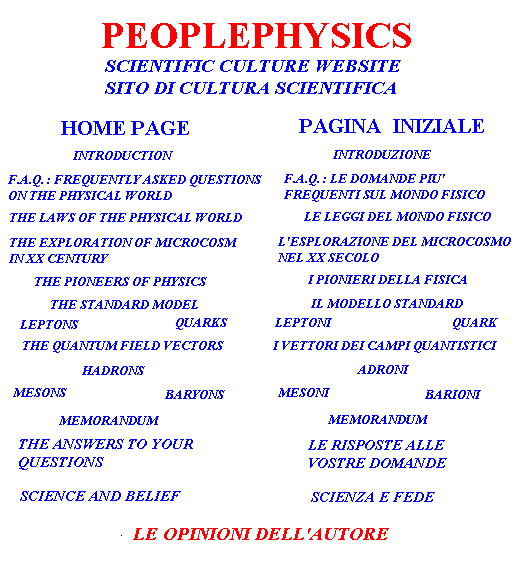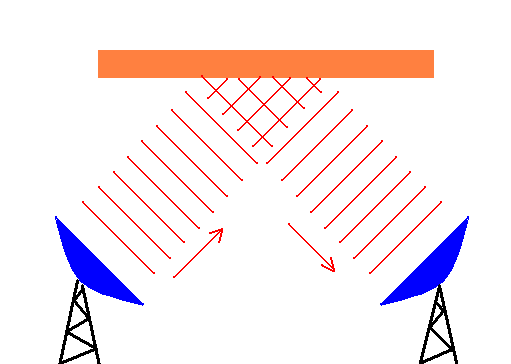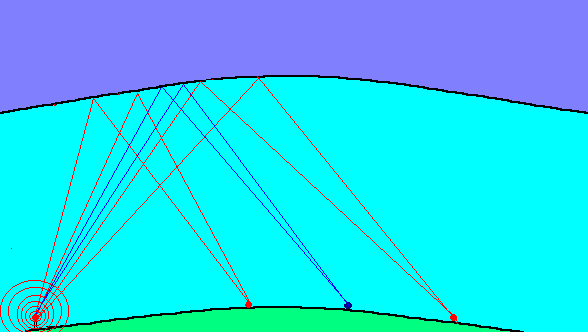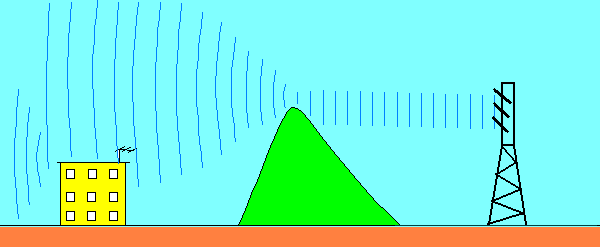

As mass is the source of the gravitational field, so electric charge is the source of
the electromagnetic field.
As a mass modifies the structure of space-time, producing a gravitational field, so any
electric charge moving with respect to the observer frame, modifies the structure of
space-time, producing an electromagnetic field, which is made of an electric field and a
magnetic field correlated each other according to Maxwell's equations.
We consider some particular cases:
1) Static electric field (electrostatic field)
If one or several charged bodies are at rest in the frame of the observer, this, measuring
by a special dynamometer the electric forces that act on little charged bodies ( testing
charges ), measures an electrostatic field, that is a static electric field, characterized
by an intensity and a direction which aren't depending on time.
2) Static magnetic field (magnetostatic field)
If one or several charged bodies are moving along a straight line with a constant speed,
the observer, using a little magnetic needle or a magnetometer, measures a magnetostatic
field, that is a static magnetic field characterized by an intensity and a direction which
aren't depending on time.
3) Non-static electromagnetic field
(resulting from a non-static electric field joined with a non-static magnetic field)
If finally one or several charged bodies are accelerated with respect to the frame of the
observer, this, using a field meter, measures the intensity of the electromagnetic field
produced by the accelerate motion of the charged bodies.
The electromagnetic field is consisting of an electric field and a magnetic field, that
are both depending on time and directed along the perpendicular each to other,and
propagate in space with the speed of light transporting electromagnetic energy.
Therefore, considering an electromagnetic field as exclusively electric (electrostatic ),
exclusively magnetic (magnetostatic) or electromagnetic non-static, it depends only on the
motion of the charged bodies with respect to the observer's reference frame .
Ideal experiment 1
If two cars are moving along a rectilinear road, maintaining, in each instant, the
same speed and the same acceleration, each driver, after having electrically charged the
body of his car and having placed outside the car a probe suitable to measure the electric field,
he can measure the exclusively electrostatic field produced by the other car, since in such
motion conditions, are equal to zero both the relative acceleration and speed of a car
with respect the other one.
Each driver sees in fact in its frame an electric charge at rest owing to the other
electric charged car, together with the relative electrostatic field.
Obviously, an observer staying at rest on the road side, sees an electromagnetic field
resulting from the vectorial sum of the electromagnetic fields produced by both cars, that
are radiating in the surrounding space, at expenses of their kinetic energy,
electromagnetic energy and momentum by means of electromagnetic waves, in a
frequency-wavelenght range depending on the motion of the charges.
The electromagnetic waves are consisting of waves of both the oscillating electric and
magnetic fields, whose polarization planes are perpendicular to each other and are
intersecting across the straight lines (lines of propagation) joining the instant position
of the moving charge with the point where the observer is placed.

Larmor showed, on the base of the Maxwell equations, that the power radiated by a
mobile electric charge with an assigned acceleration,is directly proportional to the
squared modulus of the acceleration (Larmor's formula).
An important application example of the Larmor formula is furnished by considering the
electromagnetic energy radiated by X-rays as a consequence of the impact of electrons
against the screen of a cathode ray tube (inside the cinescope of a monitor or of a
television set ).
Electrons, after having been accelerated by means of very high voltages, of about a few
tens of kV, to assuming a speed of about the 40% of the speed of light, in the impact
against the fluorescent screen, are violently decelerated, losing the most part of their
energy in the form of X-rays, that are the more penetrating, the greater is the
accelerating voltage used.
The most X-rays are absorbed inside the material of the screen, while the rest of electron
kinetic energy excites the atoms of the substance emitting light and so generates
the image.
The intensity of an electromagnetic wave is directly proportional to the square of the
intensity of the electric field ( or to the square of the intensity of the magnetic field,
since this is proportional to the one of the electric field ), is measured in W/mq, and it
is given by the sum of the specific powers (power/ unitary surface ) associated with the
electric and the magnetic fields.
In the case of plane electromagnetic waves, to which are assimilable the electromagnetic
waves with a spherical symmetry, at a great distance from the source, the intensity may be
determined with an electromagnetic field meter, or by using a radiofrequency wattmeter to
measure the electromagnetic power absorbed by a screen with an assigned area, placed with
its perpendicular along the direction of propagation.
The intensity of an electromagnetic wave is given by the modulus S
of the Poynting vector
( S = k E H ), that is directly
proportional to the intensity of the fields E and H, is always perpendicular to the plane individuated by the
electric and magnetic fields, and indicates the oriented direction along which the
electromagnetic waves are propagate.
Ideal experiment 2
We suppose a car,charged with static electricity, proceeds on a rectilinear road with a
constant speed.
In this case the driver of another car, staying at rest on the road side, would measure both
the electrostatic and magnetostatic fields generated by the moving car.
In fact the electrostatic charge of the other car, moving along a straight line and with a
constant speed, is equivalent to an electric current with a constant intensity, that
produces a static magnetic field (magnetostatic),analogous to the one produced from a
rectilinear wire in which is flowing an electric current.
If, in particular, even the car at rest has a static electricity charge, the driver of the
car in rectilinear and uniform motion can measure both the electrostatic and magnetostatic fields generated by
the car at rest on the road side.
In fact, in the frame of the moving car, the car at rest is seen to be move with an equal
and opposite velocity and to be equivalent, because of its electric charge,to an electric
current of constant intensity that produces a static magnetic field.
The Hertzian waves (radio-waves), differ from the luminous waves only for the
wavelength (in the range from some millimeters to some kilometers for the radio-waves and
from 400 to 750 nanometers for the luminous waves) and for the frequency [in the range
from an hundred of kilohertz to about some tens of GHz (gigahertz) for the radio-waves and
from 400000 to 750000 GHz for the luminous waves].
They are reflected by a conducting surface as it happens for a luminous ray reflected by a
mirror and follow the same law, according to which the angle of incidence, formed by the
direction of the coming in luminous ray or by the direction of the coming in Hertzian wave
with the perpendicular to the reflecting surface, is always equal to the reflection angle,
formed by the direction of the reflected luminous ray or by the one of the reflected
Hertzian wave with the aforesaid perpendicular.

The most known application of the reflection of Hertzian waves is the RADAR, that
permits to an airplane, a ship or a missile to locate and visualize remote metallic masses
of any type, constituted by other ships, airplanes or targets that have to be struck.
Special meteorological radars permit besides, through the reflection of impulses of
electromagnetic energy by stormy clouds, to individuate in advance approaching
perturbations .
To make the electromagnetic waves be reflected, it isn't necessary that the reflecting
surface has a great electric conductibility.
It is enough to consider that it is possible as much well to visualize mountains, and that
radar echoes also permit to measure with enough precision the distance between the Moon
and the Earth and also between the Earth and the nearer planets.
The reflection of the Hertzian waves by the ionized layers (Heaviside's layers) of the
high Earth atmosphere (ionosphere), enables the propagation to long distances of
some radio-wave bands (long-waves, middle-waves and short-waves), with a changing
attenuation during the day, because of the variable concentration of the ionized atoms
with the daily changing intensity of the solar radiation.
Hertzian waves, as the luminous waves passing through optical media with different
refraction indexes, are subjected to the phenomenon of the refraction, that is the
variation of the propagation direction that happens when they pass through atmospheric
layers with different temperatures and characterized by different refraction indexes.

If we take into account that the refraction index of a dielectric medium, permitting
the propagation of the electromagnetic waves (both the Hertzian and luminous waves ) with
a modest absorption, is definite by the ratio n = c/v between
the speed of light in vacuum (300000 Km/s) and the speed v of
light in the medium, we understand that if a medium is more refracting than another,it is
characterized by a smaller speed of propagation, that implicates, as a consequence, a
variation in the propagation direction, according to the Snell refraction law, that
affirms that the propagation direction of an electromagnetic wave, passing from a medium
to another, varies in such a mode that is constant the ratio sin a1/sin a2 = v1/v2
= n2/n1 between the sine of the incidence angle a1, formed by the coming in
wave with the perpendicular to the separation surface between both media and the sine of
the refraction angle a2,
formed by the refracted wave with the aforesaid perpendicular.
As increases the inclination a1
of the coming in wave, so increases the angle a2, in such a mode that the ratio between their sines is
always equal to the direct ratio between the propagation speeds v1
and v1 , or to the inverse ratio between the
refraction indexes n2 and n1.
The reflection and refraction laws are explained by the principle enunciated by the French
mathematician Fermat, who affirmed that a light ray covers always the path requiring the
least propagation time.
The solution of this research of the least propagation time is compatible with the
experimental results and with an economy principle of the laws of Nature, that, among all
the possible modes in which a physical phenomenon can be take place, choose always the one
minimizing time and energy (the so-called principle of the least action ).
The electric field and the magnetic field of a light ray going out of an ordinary,non-polarized
light source, oscillate in any possible plane passing through the ray.
There is, indeed, a random distribution of all the possible orientations of both the
electric and magnetic fields, which are directed perpendicularly to each other.
It is possible, however, to get some polarized light from an ordinary light source, making
a light ray pass through some special natural crystals, as quartz, calcite, tourmaline, or
synthetic materials, as the polaroids, in such a mode that can be transmitted only the
oscillations of the electric and magnetic fields that take place in the characteristic
polarization plane of the crystal.
A crystal is, indeed, an anisotropic material, that hasn't the same properties along all
the directions.
Therefore, a polarizing crystal, selecting a determinate plane of oscillation of the
electric field, is able to furnish light waves that are all characterized by the same
direction of oscillation of the electric field and also of the magnetic field, whose
direction is always perpendicular to the one of the electric field.
In the case of the herztian waves, the polarization plane coincides with the plane ,
vertical or horizontal, passing through the radiating conducting wire,that is the
transmitting antenna.
Example:
The television antennae, both the transmitting and receiving ones , consist of some rods
parallel to each other, placed in a vertical or horizontal plane, that is the polarization
plane.
Obviously, to the electromagnetic energy be picked up by the receiving antenna with the
maximal efficiency, it is necessary that the relative polarization plane is parallel to
the one of the transmitting antenna, otherwise only the component of the electric field of
the received waves along the polarization plane of the receiving antenna would be
utilized, with a decreasing intensity with the increasing angle, from 0 to 90°, between
both polarization planes.
Two antennae fed by the same transmitter and placed at a given distance from each
other, behave as two coherent sources of electromagnetic waves, that therefore radiate
electromagnetic waves between which there is a constant delay, corresponding to a constant
phase difference.
For effect of this delaies, a receiving station placed at a long distance from the
antennae, receives an electromagnetic field produced by the vectorial sum of both
electromagnetic fields, whose intensity is periodically varying with the position of the
receiving station with respect to the transmitting antennae.
In this case, the electromagnetic waves radiated by the two antennae give rise to an
interference phenomenon .
The interference produces some maximal values of the electric field (with a constructive
interference), which are twice the value of the field generated by only one antenna, in
all the points such that the difference of their distances from both antennae is equal to
a multiple of the wavelength, that is the distance l = c T = c/f (the spatial periode) covered by the wave
during the period T ( T is the
inverse of the frequency f) of oscillation of the electric
field.
If instead are considered all the points such that the difference of their distances from
the antennae is equal to an odd multiple of the half-wavelenght, a destructive
interference takes place and then the resulting electromagnetic field is zero.
The interference produces therefore a distribution of electromagnetic energy that varies
periodically with the distance of the radioreceiver from the transmitting antenna .

These weakenings and intensifications of the field happen in particular in the long
distance reception of the short waves (waves with a wavelenght range from 10 to 100 meters
), that are reflected by the ionospheric layers.
In such a case the points of the ionosphere where happens the reflection, behaves as many
coherent sources whose contributions interfere destructively or constructively with the
varying distance of the radioreceiver (fading phenomena ).
The interference of the luminous waves is gotten with special optical devices.
The ordinary light sources emit, indeed, many elementary light waves incoherent among each
other, without any temporal coordination among the single atoms.
For example, we can produce an interference phenomenon on a plane surface using two
monochromatic light rays reflected by mirrors suitable inclined between each other.
In such a case we observe a system of alternating maxima and minima of luminous intensity
( interference fringes ).

Today the most suitable method to get easily the interference of light waves uses the light of the LASER ( Light Amplification by Stimulated Emission of Radiation ), which operates according to the principles of quantum electronics, to generate light waves characterized by a spatial and temporal coherence, that is with a constant phase difference among each other.
When an electromagnetic wave is diffused by an obstacle or it is propagating across an
hole with dimensions comparable with its wavelength, takes place the phenomenon of
diffraction, that is explained by the principle of Huygens-Fresnel, according to which all
the points of the hole or of the obstacle that is placed on the propagation line of the
wave, behave as many sources of elementary spherical waves, that diffuse the energy of the
electromagnetic wave in all the directions inside the hemisphere having the center in the
obstacle or in the hole.
The elementary spherical waves interfere among each other, giving rise to a distribution
of electromagnetic energy that varies with alternating maxima and minima in terms of the
angle formed by the initial direction of propagation with the generic direction that it is
considered (in the range from 0° to 180°).

In the case of the diffraction of a monochromatic light ray across a smallest opening,
circular or rectangular, with dimensions comparable with the wavelength and made through a
opaque diaphragm, on a dark screen placed behind the diaphragm is generated a system of
diffraction fringes, respectively circular or rectangular, that correspond to maxima and
minima of the luminous intensity.
From the measure of the distance between the central fringe and one of the following
fringes, by means of the distance between the diffraction image and the diaphragm, can be
determined the wavelength of the light radiation.
Instead, if the experiment is made using white light, are observed some iridescent fringes
produced by the different maxima of light associated to radiations with different
wavelengths.

By sending on a crystal a thin beam of X-rays , that are electromagnetic waves with a
wavelength in the range from some cents and some tenth of nanometers, on a photographic
plate placed behind the crystal can be produced some diffraction fringes giving
informations on the structure of the crystal.
X-ray diffractometry is the study of crystal and molecular structure by X-ray diffraction.
In fact the X-rays that are diffused in all the directions by the single atoms of a
crystal or of a molecule, are interfering constructively only in certain angular positions
with respect to the coming in beam, permitting to reconstruct the symmetry that
characterizes the disposition of the atoms.
In 1842 the Austrian physicist Johann Christian Doppler underlined a phenomenon
pertaining to the acoustic waves, that subsequently was extended to the electromagnetic
waves.
The Doppler effect consists in the fact that the apparent frequency of the sound perceived
by a person that is moving with respect to a sound source, depends on the relative speed
between the source and the observer.
In fact, when we are invested from the acoustic waves emitted by the siren of a moving
car, we perceive an increasing frequency during the approach phase and a decreasing
frequency during the leaving phase.
The maximal frequency is perceived when the car transits before to us.
An analogous variation of the frequency of the perceived sound happens if the source is at
rest and the observer is moving.
Obviously the frequency of the sound emitted from the sound source is always the same,
whereas varies only the length of the acoustic waves that arrive from the source in motion
to the observer at rest, or the one of the acoustic waves investing the observer, when
this is approaching to the source at rest and also when this is leaving from it.
The increase and the decrease of the wavelength produced by the relative motion between
the sound source and the observer, are associated, respectively, to the decrease and the
increase of the apparent frequency that is perceived by the observer.
In the case of the electromagnetic waves, that, differently from the acoustic waves, can
propagate even in vacuum, the formula of the Doppler effect becomes much simple.
If F' is the frequency of the radio waves or of the light
waves received by the observer in relative motion in comparison with the source, V is the relative speed and F the real
frequency of the waves emitted by the source, we get:
F' = F ( 1 + V/c ), if the observer and the source are
approaching to each other (frequency increase);
F' = F ( 1 - V/c ), if the observer and the source are
leaving each other.
The associated values of the apparent (perceived) wavelengths, for little relative speed
in comparison with the speed of light are given by the formulae:
F'= c/l' ; F=c/l
;
c/l'= ( c/l ) ( 1 + V/c) ; 1/l'= (1/l) ( 1 + V/c);
l=l'(1 + V/c);
l' = l/(1+V/c) ~= l (1-V/c ),
in the case of observer and source are approaching to each other;
l'=l/(1-V/c)
~= l ( 1+V/c ) in the case of observer and source are
leaving from each other .
The Doppler effect has an important application in cosmology for the determination of the
leaving speed of the other galaxies from our galaxy.
Can be measured, indeed, the so-called "Doppler red shift", that is the
displacement toward the red (that is the increase of wavelength ) of the spectral lines
emitted by hydrogen inside the remote galaxies.
In fact, since can be known by the spectroscopic analysis the real wavelength l of an assigned spectral line of hydrogen, from the
measure of the apparent wavelength of the same spectral line emitted by the galactic
hydrogen, the leaving speed V can be calculated.